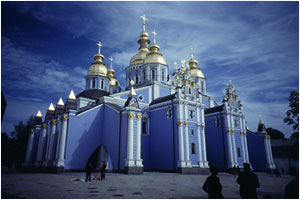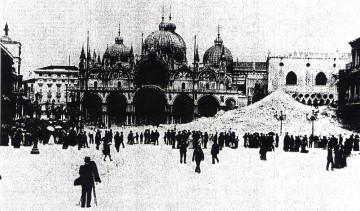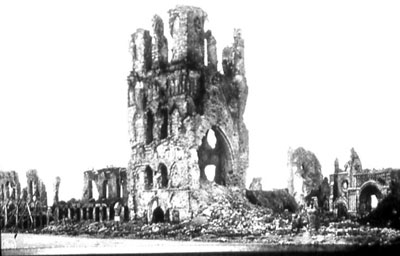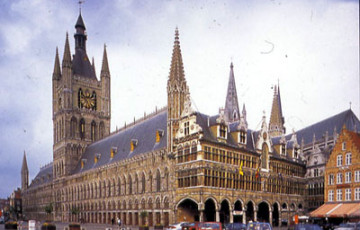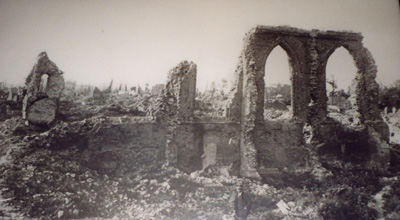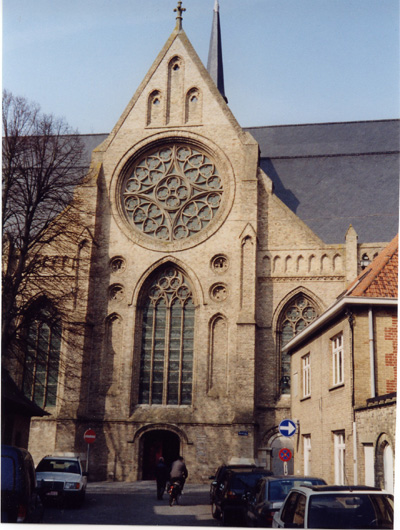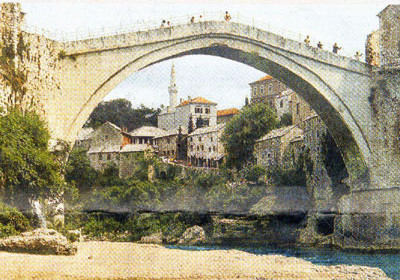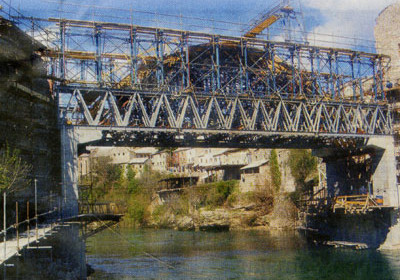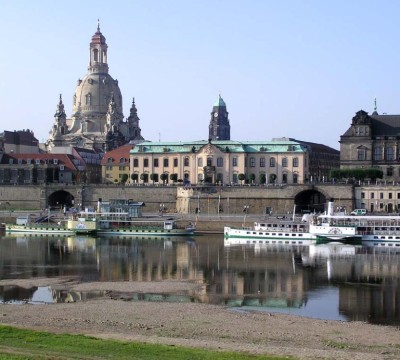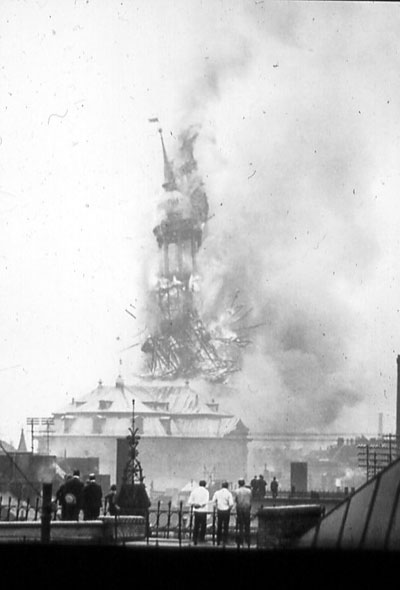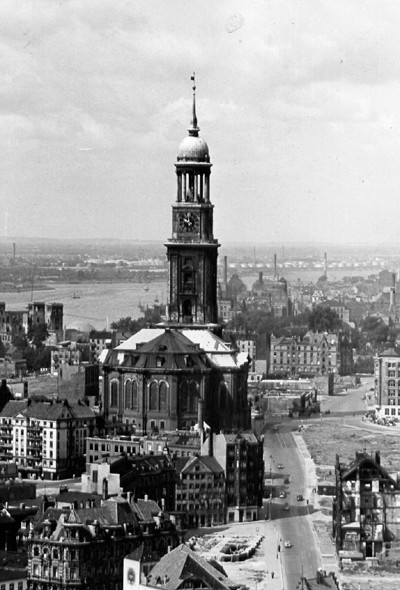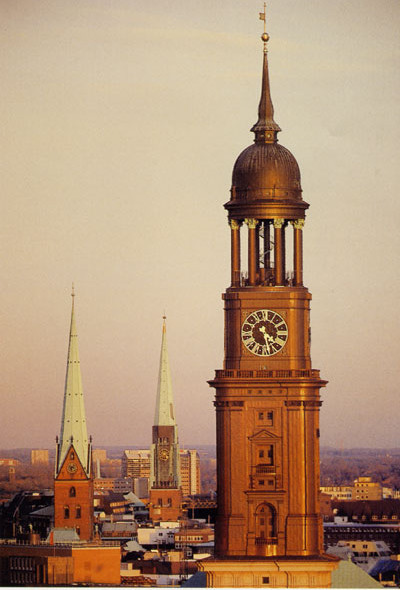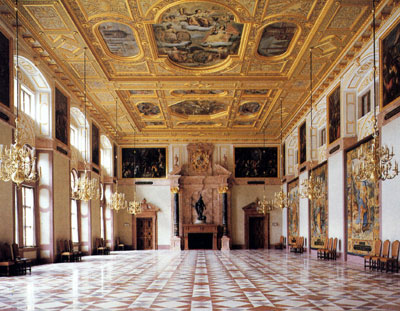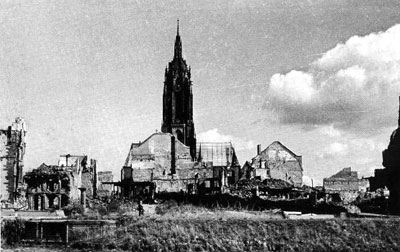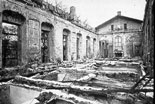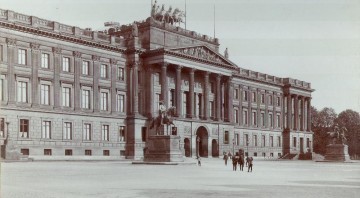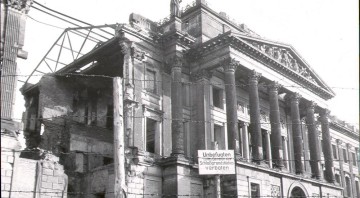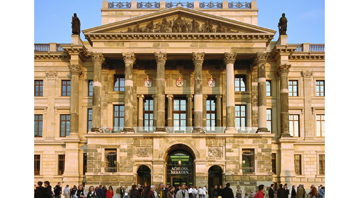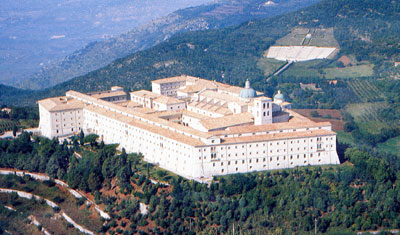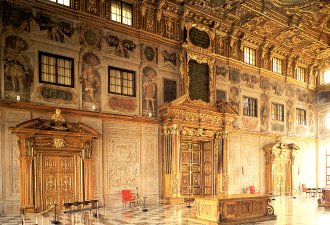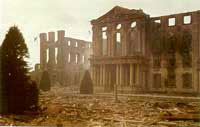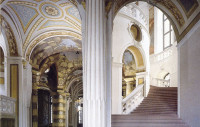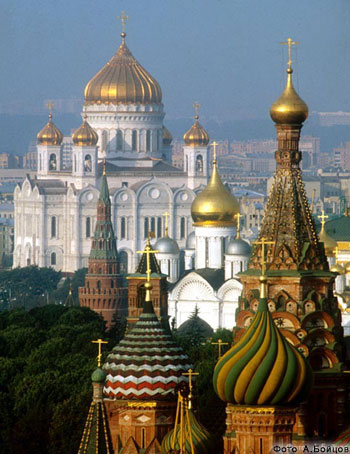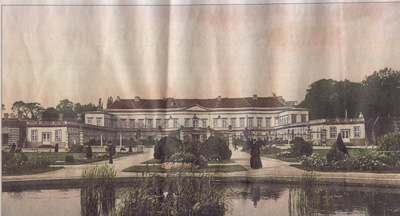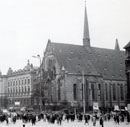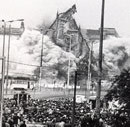Everywhere in the world, buildings which are important for the identity of the city and their region and which carry on the city’s history, are reconstructed after they have been fully destroyed. In Japan for over 1,000 years Shinto shrines have been rebuilt again and again. They are made of wood which easily rots. Accordingly, they have two foundations. If the predecessor temple shows signs of decay, a new temple is built in the same style and manner on the neighboring foundation and the old one is torn down.
In this respect, architecture, which is the mother of the fine arts, plays a middle role. Certain branches of the fine arts, such as music and theater, live exclusively via reproduction. Others are not reproducible, as is the rule with painting. In that case, the artist’s hand is seen in the last detail, without leaving behind for posterity his thoughts in the form of plans or music scores. In architecture, the architect’s genius is to be found in the plans. Hardly a single architect of a gothic cathedral lived to see its completion, perhaps at most the finishing of the apse. Hundreds of stone masons and sculptors, bricklayers, and other manual laborers brought his idea to completion, often generations later. If the plans or comprehensive documentation exist, such buildings can be rebuilt, and continuity maintained.
Because of weathering, all historical buildings have long since experienced one, or often multiple, renewals of their facades. They thus have become copies of themselves. Likewise the demolished Berlin Palace was comprehensively restored in the 19th century. Thus Walter Ulbricht, who ordered its destruction, destroyed largely a copy of Schlüter’s building, but not its essence.
Again and again there are arguments as to whether one should rebuild such totally destroyed structures. Opponents of this project toss around not exactly accurate terms such as “clone”, “Disneyland” or “Las Vegas”. How unjustified they are, is shown by the pictures on this page of buildings that have been reconstructed true to their originals and which bear witness to the reclaimed historical identity of famous cities. Often the reconstruction does not occur immediately after loss. Political or also economic conditions prevent it.
Kiew
The St. Michael’s Cloister in Kiev, Ukraine. It was called the “Gold covered” and stemmed from the 12th century. 1935/36 at the high point of Stalin’s persecution of the church, it was blown up and cleared away. After the fall of the Soviet Union, reconstruction was begun in the 1990s. Today it stands again in its former beauty.
Other countries are not so complicated as ours is when it comes to the reconstruction of historical edifices. For them, in contrast to us Germans, it is much more a matter of their cultural history, which witnesses to the country’s history.
Venedig
In Venedig brach Anfang des 20. Jahrhunderts der Campanile auf dem Markusplatz zusammen, als man einen Fahrstuhl für die Touristen einbauen wollte. Nach kurzer Diskussion entschied man sich für den Wiederaufbau des Turms. Heute weiß kaum ein Besucher der Stadt, das hier eine Kopie den wichtigsten Platz der Stadt beherrscht, für ihn ist nur die Homogenität des historischen Stadtbildes sichtbar.
Ypern / Belgien
Dijksmuide, Belgien
Everywhere in the world, buildings which are important for the identity of the city and their region and which carry on the city’s history, are reconstructed after they have been fully destroyed. In Japan for over 1,000 years Shinto shrines have been rebuilt again and again. They are made of wood which easily rots. Accordingly, they have two foundations. If the predecessor temple shows signs of decay, a new temple is built in the same style and manner on the neighboring foundation and the old one is torn down.
In this respect, architecture, which is the mother of the fine arts, plays a middle role. Certain branches of the fine arts, such as music and theater, live exclusively via reproduction. Others are not reproducible, as is the rule with painting.
In that case, the artist’s hand is seen in the last detail, without leaving behind for posterity his thoughts in the form of plans or music scores. In architecture, the architect’s genius is to be found in the plans. Hardly a single architect of a gothic cathedral lived to see its completion, perhaps at most the finishing of the apse. Hundreds of stone masons and sculptors, bricklayers, and other manual laborers brought his idea to completion, often generations later. If the plans or comprehensive documentation exist, such buildings can be rebuilt, and continuity maintained.
Because of weathering, all historical buildings have long since experienced one, or often multiple, renewals of their facades. They thus have become copies of themselves. Likewise the demolished Berlin Palace was comprehensively restored in the 19th century. Thus Walter Ulbricht, who ordered its destruction, destroyed largely a copy of Schlüter’s building, but not its essence.
Again and again there are arguments as to whether one should rebuild such totally destroyed structures. Opponents of this project toss around not exactly accurate terms such as “clone”, “Disneyland” or “Las Vegas”. How unjustified they are, is shown by the pictures on this page of buildings that have been reconstructed true to their originals and which bear witness to the reclaimed historical identity of famous cities. Often the reconstruction does not occur immediately after loss. Political or also economic conditions prevent it.
Orleans, Frankreich
Thus the gothic cathedral of Orleans, France was flattened during the Huguenot wars of the 16th century. For almost 150 years thereafter there was only an empty square in its place. Only in the 18th century, during the flowering of the French rococo, was it again erected true to the original in the gothic style after the old plans, and subsequently reopened in the 19th century. Today, although it is only 200 years old, no one looks upon it anymore as not being an original structure from the gothic period. Yet the collective memory of the city which is grounded in the identity of this ensemble, has been unmistakably resurrected.
Köln am Rhein, Groß St. Martin
Mostar, Bosnien Herzegowina
Thus it is only logical that at the conference of the European monuments protection authorities in 1994 it was decided (by the way against the votes of the Germans) that the city of Mostar, with the Stari Most, with the old bridge and its minarets, should be rebuilt immediately after the end of the Yugoslavian civil war.
Thus it is only logical that at the conference of the European monuments protection authorities in 1994 it was decided (by the way against the votes of the Germans) that the city of Mostar, with the Stari Most, with the old bridge and its minarets, should be rebuilt immediately after the end of the Yugoslavian civil war.
The cityscape of Mostar, lying on the former border between catholic Europe and the Ottoman Empire is an important component of the European memory.
It’s irrevocable loss through reconstruction in the modern style would also have destroyed forever the remembrance of the period of Turkish domination in central Europe.
Hildesheim / Niedersachsen
Hildesheim. The Hotel Hotel Rose remained only for 20 years. then it’s architecture had no friends anymore. Hildesheim got back it’s city-identity: The “Knochenhaueramtshaus” returned.
Hildesheim wollte eine neuzeitliche Stadt werden, raus aus der mittelalterlichen Enge, lichtdurchflutet und weiträumig angelegt. Dieser Planung fielen auch die historischen Proportionen des Rathausmarktes zum Opfer. Das Hotel “Rose” ging als preisgekrönter Sieger für einen Neubau auf dem Standort des historischen Konochenhaueramtshaus hervor – und wurde gebaut. Nach 20 Jahre hatten die Hildesheimer genug davon: Eine Bürgerinitiative setzte den Abriß des Hotels und den Wiederaufbau des Fachwerkhauses durch – und fand sogar einen Investor dafür. Heute ist für die Hildesheimer die Welt in ihrer Heimatstadt wieder in Ordnung.
Dresden
Dresden, 2002. The Frauenkirche’s reconstruction is almost finished. Only a few old stones could be used, most of them had to be completely renewed. Bjut in a few decades tghe new stones have darkened and then nobody can see a difference between the ancient parts of the Church and the new ones. The old Dresden Identity has returned.
Many completely or heavily destroyed buildings all around Europe have been reconstructed after World War II. Their cities got back the historic memorial, their old identity. Many cities in Germany, being complete rebuild in modern architecture, still seek for it.
Hamburg
The second Copy of St. Micheli’s Church in 2000. Again the copper had to be renewed after the complete reconstruction of 1912. so this is the 3rd Tower of the Church since 1755, all looking the same.
Die brennende Michaeliskirche, das Wahrzeichen Hamburgs 1906
Der Turm stürzt in das Kirchenschiff, auch dieses brennt vollständig aus
Die Kopie der Michaeliskirche um 1950. Heute erneut mit einer neuen Kupferhaut versehen, ist der Turm inzwischen die 3. Ausführung des Plans von 1755
Warschauer Schloss
Münchener Residenz
München, Residenz. The Emperor’s Hall after being rebuild in 1985, This work was especially difficult as this hall did not exist since 1799. Only some paintings helped to do this marvellous reconstruction.
Frankfurt am Main
Die Ostzeile des Frankfurter Römerbergs 1945 und heute.
Berlin: Schloss Charlottenburg
Braunschweig: Schloss
Italien: Kloster auf dem Monte Cassino
Das Kloster Monte Cassino in Italien 1944, verwüstet durch allierte Bombenangriffe, die dort einen Befehlsstand der deutschen Wehrmacht vermuteten.
Das völlig zerstörte Kloster 1944 und nach seiner Rekonstruktion
Augsburg: Rathaus und Goldener Saal
Das berühmte Augsburger Rathaus, Prachrtbasu der süddeutschen Renaissance wurde im 2. Weltkrieg bis auf die Umfassungsmauern zerstört. Nach dem eigentlichen Wiederaufbau wurde der Goldene Saal zunächst in moderner Form in der Architektur der 50er Jahre eingefügt und erst um 1985 in seiner alten Pracht rekonstruiert.
Schloss Bruchsal / Baden-Württemberg
Schloss Bruchsal. 1944 fast völlig zerstört, zeugt es heute wieder von seiner alten Schönheit
Moskau, Erlöserkathedrale
Moskau: Die von Stalin in den dreißiger Jahren gesprengte und vollständig beseitigte Erlöserkathedrale (im Hintergrund) nach ihrer Rekonstruktion. An ihre Stelle sollte nach der Zerstörung ursprünglich ein Hochhaus gesetzt werden, aber es reichte nur zu einem riesigen Schwimmbad. Nach der Wende 1990 wurde sofort mit ihrem Wiederaufbau begonnen.
Weitere, erfolgreiche Rekonstruktionen:
Deutschland
- Dresden: Zwinger und Schloss, Altstadt
- Stuttgart: Neues Schloss
- Karlsruhe: Schloss und Altstadt
- Mannheim: Schloss
- Würzburg: Residenz und Altstadt
- Berlin-Mitte: Kronprinzenpalais, Zeughaus, Oper, Kronprinzessinenpalais, Französischer Dom, Humboldt-Universität, Kaiser Wilhelm Palais, Königliche Bibliothek Hedwigskathedrale, Bauakademie, Museumsinsel, Marstall, Ephraim Palais, Nikolaikirche u.a.m.
- Lübeck: Altstadt, Marienkirche, Dom u.a.m
- Münster: Altstadt, Prinzipalmarkt
- Mainz: Häuserzeile am Marktplatz
Russland
- Moskau: Kasan-Kathedrale, Erlöser-Kathedrale
- St. Petersburg: Schlösser Zarskoje Zelo, Peterhof u.a.m
- Königsberg / Kaliningrad: Rekonstruktion des Doms
Polen
- Danzig: Altstadt
- Breslau: Altstadt
- Stettin: Schloss und Altstadt
- Elbing: Altstadt
- Marienburg: Ordensburg des Deutschen Ritterorden
- Warschau: Altstadt und Schloss
Weitere Länder und Städte
- Riga, Lettland: Schwarzhäupterhaus, Rathaus, Teile der Altstadt
- Hiroshima, Japan: Schloss, Rekonstruktion 1958
- Reims, Frankreich: Kathedrale
- Seoul, Korea: Koreanischer Kaiserpalast, abgebrochen durch japanische Order 1912, jetzt in der Rekonstruktion
- Istanbul, Türkei: Ciragan Palast, das Gebäude des Osmanischen Parlaments. 1910 einem Feuer zum Opfer gefallen, Rekonstruktion 1985 bis 1992.Heute Hotel Kempinski
- Toledo, Spanien: Alcazar und Altstadt, völlig zerstört im spanischen Bürgerkrieg
Gewünschte und im Einzelfall auch schon beschlossene Rekonstruktionen
Potsdam Stadtschloss
Realisierung zwischen 2008 und 2012 als Landtag von Brandenburg. Initiiert durch eine Spende von Günther
Jauch, zunächst Bau des Fortuna-Portals.
Durch eine neue Großspende über 20 Mio Euro von Hasso Plattner, SAP AG, im
November 2007 kann nun die Rekonstruktion des Äußeren nach den Plänen von Knobelsdorff ausgeführt werden. Fertigstellung voraussichtlich 2012.
Leipzig
Universitätskirche (Paulinerkirche) am Augustusplatz
Wiederaufbau nur im Inneren (Kirchenschiff) als Aula der Universität in stark verfremdeter Form
Im Jahre 2004 wurde in einem erneuten Wettbewerb entschieden, einen modernen Universitätsbau nach dem Entwurf des niederländischen Architekten Eggerat zu errichten. Er zitiert im Äußeren in moderner Formensprache die Kirche und das Augusteum und sieht als Aula die weitgehende Rekonstruktion der gotischen Kirchenhalle mit Netzgewölben vor. Dieser Kompromiss fand auch die Zustimmung der Vertreter des Paulinerkirchenvereins. In der Aula ist die würdige Anbringung der Kunstschätze der Kirche möglich.
 English
English




